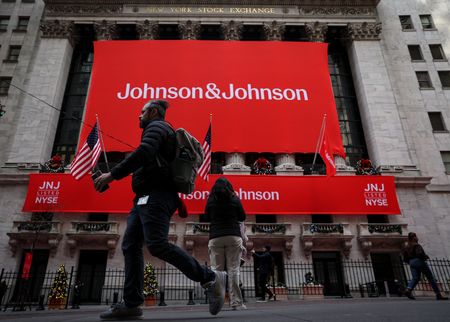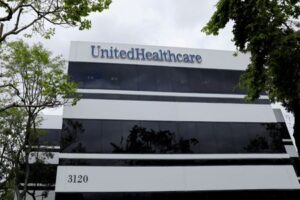By Patrick Wingrove and Bhanvi Satija
(Reuters) -Johnson & Johnson’s first-quarter revenue missed Wall Street estimates for medical devices on Tuesday and sales of its blockbuster psoriasis drug Stelara came in lower than expected as the company prepares for its loss of exclusivity in the U.S.
J&J’s large medical devices business reported $7.82 billion in sales for the quarter, boosted by strong demand for Abiomed heart pumps and devices used in wound closure surgeries.
That was still short of analysts’ estimates of $7.88 billion. Two analysts pointed to a weakness in J&J’s vision care products and surgical devices.
“China-related issues seemed to play a restraining role in both divisions’ underperformance,” said Stifel analyst Rick Wise.
J&J shares were down 1.3% at $145.71. Shares of other medical device makers Zimmer Biomet, Stryker and Medtronic were also down about 1%
Sales of Carvykti, a cell therapy cancer treatment that analysts expect to bring in $1.15 billion this year, was $157 million for the quarter, missing Wall Street estimates of $200 million.
Supply has been a constraint on Carvykti sales, Wolk said, but added that the company was working with the U.S. FDA to enable increased capacity at its plants in New Jersey and Belgium.
J&J has doubled its manufacturing capacity for cell processing since 2023, a company executive said on an investor call. The drugmaker expects sales of Carvykti to continue to grow this year, particularly in the second half, as it expands capacity.
Sales of cancer drug Darzalex jumped 19% to $2.69 billion, about in line with expectations. The multiple myeloma treatment is expected to bring in sales of more than $11 billion this year, according to analysts.
Stelara sales were flat at $2.45 billion, falling short of analysts’ expectations of $2.6 billion, according to LSEG data.
J&J Chief Financial Officer Joe Wolk said Stelara revenue was flat because of contracting with healthcare providers and pharmacy benefit managers in anticipation of the drug’s loss of exclusivity in the U.S. next year.
“We probably expect this year to be flattish, maybe a little bit up in the United States, as we prepare for some contracts to preserve volume, but maybe give a little bit on price for the longer term,” Wolk said.
J&J has struck deals to delay U.S. launches of biosimilars, or close copies, of Stelara until 2025, after a key patent expired last year.
Analysts have said the delayed competition will make the drug a larger contributor for J&J’s 2024 and 2025 revenue than previously anticipated.
Stelara biosimilars are expected to launch elsewhere later this year. J&J reached an agreement with Alvotech in February to launch its version in Japan, Canada and Europe this year. The Luxembourg-based drugmaker began selling the medicine in Canada last month under the name Jamteki and can launch in Japan in May.
‘SIGNIFICANT FLEXIBILITY’ FOR DEALS
J&J announced this month that it had agreed to buy Shockwave Medical for $13.1 billion to acquire its device that uses vibrations to break down calcium deposits in heart vessels.
Wolk said operational growth in medical devices this quarter – up 6.3% from the year-ago quarter – “probably speaks to why we were seeking to add to that portfolio with the potential acquisition of Shockwave.”
CEO Joaquin Duato said the company was still in the market for deals or acquisitions. “We have significant flexibility to consider multiple types of transactions,” he said on the investor call.
On an adjusted basis, J&J earned $2.71 per share in the first quarter, beating estimates 7 cents. It reported total revenue of $21.38 billion, shy of estimates of $21.40 billion.
J&J raised the low end of its 2024 forecast by 5 cents and now expects an adjusted profit of $10.60 to $10.75 per share.
It also increased its quarterly dividend by 4.2% to $1.24 per share.
(Reporting by Bhanvi Satija and Mariam Sunny in Bengaluru and Patrick Wingrove in New York; Editing by Shounak Dasgupta and Bill Berkrot)





